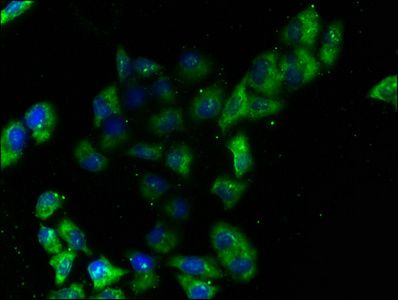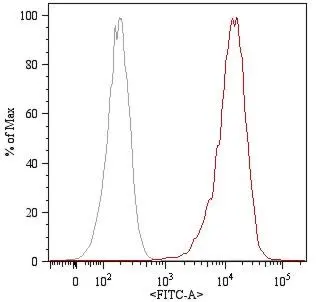![FACS analysis of KG1 cells using GTX11414 CD105 antibody [SN6]. FACS analysis of KG1 cells using GTX11414 CD105 antibody [SN6].](https://www.genetex.com/upload/website/prouct_img/normal/GTX11414/GTX11414_233_FACS_w_23060501_509.webp)
FACS analysis of KG1 cells using GTX11414 CD105 antibody [SN6].
CD105 antibody [SN6]
GTX11414
ApplicationsFlow Cytometry, ImmunoPrecipitation, Western Blot, ImmunoHistoChemistry, ImmunoHistoChemistry Frozen
Product group Antibodies
TargetENG
Overview
- SupplierGeneTex
- Product NameCD105 antibody [SN6]
- Delivery Days Customer9
- Application Supplier NoteFACS: 1/50. *Optimal dilutions/concentrations should be determined by the researcher.Not tested in other applications.
- ApplicationsFlow Cytometry, ImmunoPrecipitation, Western Blot, ImmunoHistoChemistry, ImmunoHistoChemistry Frozen
- CertificationResearch Use Only
- ClonalityMonoclonal
- Clone IDSN6
- Concentration1 mg/ml
- ConjugateUnconjugated
- Gene ID2022
- Target nameENG
- Target descriptionendoglin
- Target synonymsEND, HHT1, ORW1, endoglin, CD105 antigen, soluble endoglin
- HostMouse
- IsotypeIgG1
- Protein IDP17813
- Protein NameEndoglin
- Scientific DescriptionThis gene encodes a homodimeric transmembrane protein which is a major glycoprotein of the vascular endothelium. This protein is a component of the transforming growth factor beta receptor complex and it binds to the beta1 and beta3 peptides with high affinity. Mutations in this gene cause hereditary hemorrhagic telangiectasia, also known as Osler-Rendu-Weber syndrome 1, an autosomal dominant multisystemic vascular dysplasia. This gene may also be involved in preeclampsia and several types of cancer. Alternatively spliced transcript variants encoding different isoforms have been found for this gene. [provided by RefSeq, May 2013]
- Storage Instruction-20°C or -80°C,2°C to 8°C
- UNSPSC12352203
References
- Higher Chondrogenic Potential of Extracellular Vesicles Derived from Mesenchymal Stem Cells Compared to Chondrocytes-EVs In Vitro. Hosseinzadeh M et al., 2021, Biomed Res IntRead more
- Decellularized extracellular matrix loaded with IPFP-SC for repairing rabbit osteochondral defects. Li L et al., 2021, Am J Transl ResRead more
- Effect of Activated Platelet-Rich Plasma on Chondrogenic Differentiation of Rabbit Bone Marrow-Derived Mesenchymal Stem Cells. Wang Z et al., 2021, Stem Cells IntRead more
- Phenotypical Characterization and Neurogenic Differentiation of Rabbit Adipose Tissue-Derived Mesenchymal Stem Cells. Tirpakova M et al., 2021 Mar 17, Genes (Basel)Read more
- Autologous Fractionated Adipose Tissue as a Natural Biomaterial and Novel One-Step Stem Cell Therapy for Repairing Articular Cartilage Defects. Li Q et al., 2020, Front Cell Dev BiolRead more
- Combined approach for characterization and quality assessment of rabbit bone marrow-derived mesenchymal stem cells intended for gene banking. Vaicek J et al., 2020 Jan 25, N BiotechnolRead more
- Mitochondrial Transfer of Whartons Jelly Mesenchymal Stem Cells Eliminates Mutation Burden and Rescues Mitochondrial Bioenergetics in Rotenone-Stressed MELAS Fibroblasts. Lin TK et al., 2019, Oxid Med Cell LongevRead more
- Survivability of rabbit amniotic fluid-derived mesenchymal stem cells post slow-freezing or vitrification. Kulikova B et al., 2019 May, Acta HistochemRead more
- Comparison of surface markers between human and rabbit mesenchymal stem cells. Lee TC et al., 2014, PLoS OneRead more



![FACS analysis of KG1 cells using GTX11415 CD105 antibody [SN6] (FITC).](https://www.genetex.com/upload/website/prouct_img/normal/GTX11415/GTX11415_239_FACS_w_23060501_591.webp)
